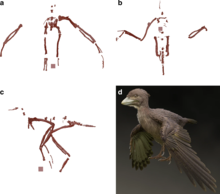Fukuipteryx
| Fukuipteryx | |
|---|---|

| |
| Reconstructions and restoration. a–c Skeletal reconstructions of FPDM-V-9769 in cranial (a), dorsal (b), and left-lateral (c) views. d Life restoration of Fukuipteryx prima | |
| Scientific classification | |
| Domain: | Eukaryota |
| Kingdom: | Animalia |
| Phylum: | Chordata |
| Clade: | Dinosauria |
| Clade: | Saurischia |
| Clade: | Theropoda |
| Clade: | Avialae |
| Genus: | †Fukuipteryx Imai et al., 2019 |
| Species: | †F. prima
|
| Binomial name | |
| †Fukuipteryx prima Imai et al., 2019
| |
Fukuipteryx is an extinct genus of basal
Discovery and naming
In 2013, the first associated skeleton of an Early Cretaceous avialan from Japan was collected at the Kitadani Dinosaur Quarry in Katsuyama, Fukui, central Japan. The specimen is three-dimensionally preserved, and exhibits several autapomorphies, which led to the creation of a new taxon.[1]
In 2019, the type species Fukuipteryx prima was named and described by Takuya Imai, Yoichi Azuma, Soichiro Kawabe, Masateru Shibata, Kazunori Miyata, Wang Min and Zhou Zhonghe. The genus name combines a reference to Fukui with the Ancient Greek pteryx, meaning "feather". The specific name means "the first" in Latin and refers to its basal position on the avialan phylogenetic tree.
The
Description
Fukuipteryx was about the size of a modern
Fukuipteryx shows several
Phylogeny
A
References
- ^ a b c d e Imai, T., Azuma, Y., Kawabe, S., Shibata, M., Miyata, K., Wang, M., & Zhou, Z. (2019). An unusual bird (Theropoda, Avialae) from the Early Cretaceous of Japan suggests complex evolutionary history of basal birds. Communications Biology, 2(1). doi: 10.1038/s42003-019-0639-4
- ^ "New Dinosaur-Era Bird Discovered in Japan: Fukuipteryx prima". Sci News.com. Enrico de Lazaro.
